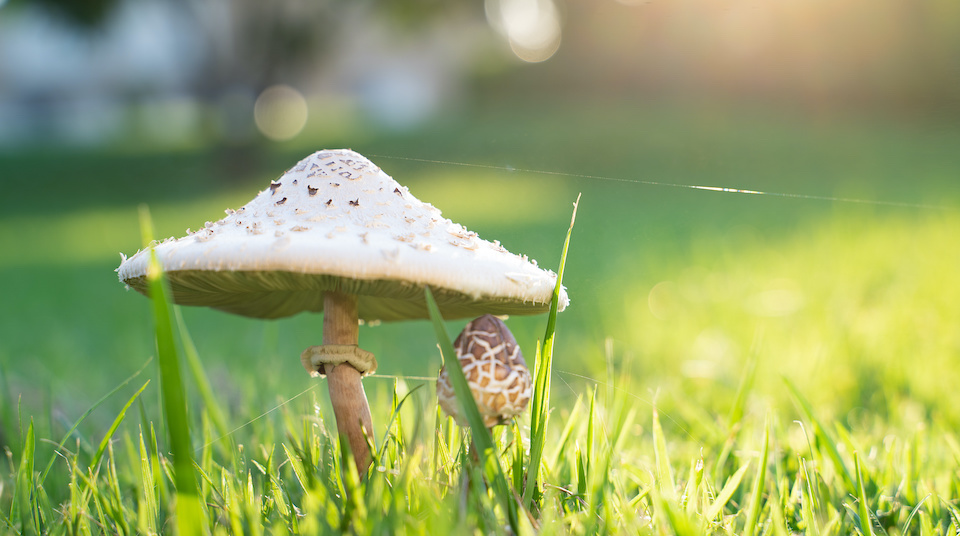If you’re noticing mushrooms popping up on your lawn, you shouldn’t be surprised or concerned. It simply means that autumn is on the way, which is the prime time for fungal growth. Fungi live in your soil at all times – they are a vital part of the ecosystem and help keep plants healthy. At the right time of year and when the weather conditions are perfect, they pop up these little fruiting bodies to spread spores and reproduce. You may have noticed that fungi proliferate in wet weather that occurs right after a dry spell, or when you’ve just laid new turf. The disturbed soil releases fungal spores that were previously dormant, so you get lots of toadstools popping up on that nice new lawn.
The fungus kingdom is incredibly diverse. While only 50,000 species have been described in North America, scientists believe that over 5 million species could exist worldwide. Some of these are incredibly nutritious, providing B vitamins, vitamin D, and minerals such as selenium and zinc. Some species are recognized for their benefits in maintaining health and preventing disease.
What about those mushrooms on the lawn?
Lawn mushrooms are not generally poisonous to humans, but as a precaution, it’s wise not to try eating them unless you are 100 percent sure that you can identify them accurately. Mushrooms may have different effects on pets and humans. For instance, a mushroom that is edible for people could be dangerous to pets and vice-versa.
Since there are so many dangerous mushrooms species, it’s essential to teach children never to touch or eat mushrooms they may discover in the yard. About 100 known species of mushrooms can cause a negative reaction if ingested, so take precautions, especially if your child is curious or tends to put things in their mouth.
The best wild mushrooms you can eat
There are a few edible species that are relatively easy to identify, so they could be considered the best bet for aspiring mushroom hunters.
- Morel (Morchella esculenta) mushrooms are found across much of the U.S., especially under hardwood trees, in orchards, and in disturbed soil. They have a distinctive “honeycomb” cap that is deeply wrinkled and yellow-grey. Morels are 2 to 9 centimeters tall by 2 to 5 centimeters thick, and hollow through the center.
- Fairy Ring (Marasmius oreades) mushrooms are widely distributed across North America and often grow in grassy areas such as lawns and fields. They tend to grow in a ring or arc, have a white or pale tan color, a bell-shaped cap, well-spaced forked gills, and a tough stem. Once you have verified that you’ve identified these tasty mushrooms correctly, you can come back year after year to the same spot to pick more.
- Hen Of The Woods (Grifola frondosa) mushrooms are found at the base of trees, especially oak trees in the northeast, ranging as far west as Idaho. They grow in a large clump that some describe as coral-like, with white branching stalks and greyish-brown curled caps.
Besides these distinctive species, there are many other common lawn mushrooms that are nontoxic and even edible. However, they are often too similar to poisonous species, and so are not recommended without consulting an expert.
How to avoid dangerous mushrooms
Follow these guidelines for avoiding poisonous mushrooms if you are a novice. While these rules don’t mean all other mushrooms are safe, they are good general guidelines to follow.
- Avoid mushrooms with white gills, a skirt or ring on the stem, and a bulbous base. This helps avoid the deadly members of the Amanita family. A deadly species known as the Death Cap (Amanita Phalloides) is commonly mistaken for edible mushroom species due to its relatively ‘friendly’ white appearance, but the bulbous base and white gills give it away.
- Avoid mushrooms with red on the cap or stem. While some good mushrooms have red features, more often, they are the poisonous ones.
Most importantly, don’t consume any mushrooms unless you are entirely sure of what they are. Many edible mushrooms can have poisonous lookalikes. Keep in mind that cooking, heating, and salting do not destroy poisons inside the mushrooms. If you do decide to try consuming wild mushrooms, do so in moderation. Try a small amount, then wait a few hours, and keep some of the fungi aside to show a professional in case you experience negative effects.
How to get rid of pesky mushrooms on our lawn
If you decide not to grow mushrooms in your backyard, whether because they are unsightly or to minimize danger to curious children or pets, there is a simple trick to keep them from coming back.
Epsom salts are all you need! Epsom salt should not damage your grass and will help fertilize soil, balance the pH, and help get rid of unwanted mushrooms. Simply grab a large watering can and fill with water. Add four teaspoons of Epsom salts and stir in to dissolve, then pour over the affected area.
While those backyard mushrooms might look delicious for a pizza or stirfry, it’s best to leave them undisturbed. Stick with the tried-and-true supermarket varieties, or try safely cultivating your own indoors!
-Susan Patterson



